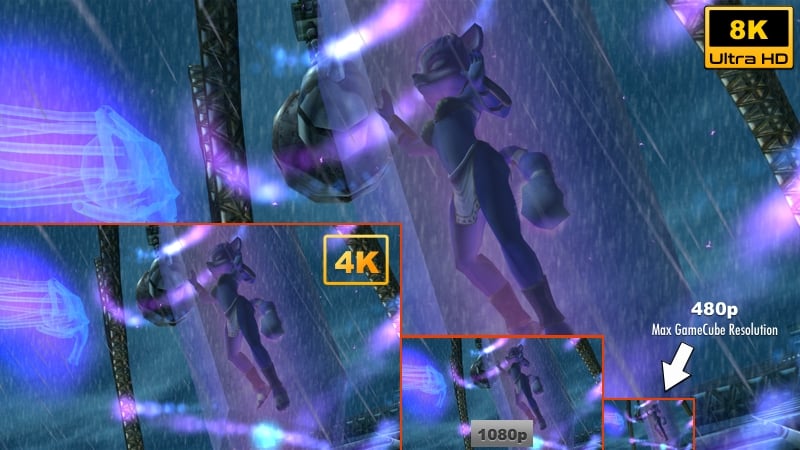8K Video Krystal Experiment
This is an experiment in 8K rendering on GameCube via the Dolphin emulator. I managed to record a cutscene from Star Fox Adventures at full quality, using maximum available settings on the emulator, at a higher resolution than 8K.
What is 8K? Well, it's 7680×4320 resolution, 4 times larger than 4K, or 16 times larger than 1080p Full HD. It means over 33 million pixels per frame. But what do all those numbers mean? Here, this image should help. Click the image to see its full resolution, which is at actual 8K size.
Pretty cool, eh?
Anyway, this is my first 8K video on YouTube, and probably the last one for a while. You see, there are only two or three displays in the world capable of showing this video. Some movie theaters might be able to, but it'll be at least a year before your average consumer will begin to start purchasing these screens. I only just upgraded to 4K monitors and TVs myself.
If you are interested in the technical details of the process, read below!
Technical Details
I used a hidden EFBScale=12 setting to get the Dolphin to render the game at an astounding 7942x4752 pixels. This was recorded via the Dolphin's frame dump feature at 60fps. I used the maximum possible settings for anti-aliasing (8xSSAA) and anisotopic filtering (16x). The encoding was done via the FFV1 Lossless Video codec, resulting in no lost data due to compression. These are the highest possible settings for their respective categories without modifying the source code of the Dolphin. Note that at these resolutions and settings, I had to change my desktop resolution to 1080p to prevent the GPU from crashing when trying to render 8K footage. Even then, enabling 8xSSAA often caused the emulator to crash. I had to carefully re-enable it during the gameplay.
At these massive settings, the game only rendered at about 10-20fps. When recording frame dumps, however, the emulation slowed down to less than 2fps. Thus, it took over an hour to record this video.
The resulting video file, just over 1 minute and 20 seconds long, created a 28.6 gigabyte file. Since I do not have a player capable of viewing video at this size, I had to to down-convert the video to a lower resolution just to preview it. All of my work with the video had to be done via FFMPEG, the command line tool, rather than a non-linear video editor.
After several false starts and glitches, I managed to correctly cut the video to remove unwanted portions of the beginning and end of the video. I also removed unneeded portions of the audio dump wav file, so that it would be shorter and synced with the now-cut video. In the final step, I did several operations in a single conversion: I merged the audio and video, resized the resolution down to 8K's horizontal width (7680), then cropped the top and bottom to give a perfect 8K resolution (7680x 4320), and converted it to the low-compression, highest-possible-quality version of ProRes ("prores_ks -profile v:4 yuv444p10"). Cropping didn't delete any data, because this cutscene has black bars on the top and bottom.
Most encoding, especially at full resolution, took anywhere from 15 minutes to an hour and a half to perform on my computer (Intel i7 with GeForce GTX 760 and 32 GB of RAM).
The resulting ProRes file was 63.1 gigabytes! YouTube recommends uploads using the H.264 codec. However, H.264 only supports resolutions up to 4K. As a result, after some recommendations I found online, I went ahead and uploaded the 63 GB video directly to YouTube. Thanks to my amazing Google Fiber connection, it only took 30 minutes to upload! YouTube took about an hour to get 1080p 60fps footage available, and another 4 or 5 hours to make 4K 60fps and 8K 60fps available.
I hope that this will be instructive to people wishing to do their own game recordings, and to recognize how powerful the Dolphin and GameCube games truly are.

Comments
Really awesome! I did a couple screenshots from Dolphin for SFAd a while back in 1920×1080, while using the flycam hack to get different angles with maxed out anti-aliasing and anisotropic filtering. I thought they turned out pretty interesting, but this takes the cake!
(GDrive link for anyone who wants the images I captured: https://drive.google.com/drive/folders/0B_1-tukQ_S2gMDg1dVNMcHZFdDQ?usp=sharing )
it look nice, but if they did remastered it’ll need high poly model and higher texture resolution.
Nice, but I still wish that Krystal wasn’t a coward/damsel in distress/traitor.
@J.T. Gillin
Coward?
It’s so cool that Dolphin is able to do that! I’ve always wondered about making a high res texture pack for Adventures. I tried my hand at it, but it turns out I’m not a very good texture artist. It’d be cool to find some like-minded people willing to take on such a task.
That said, Adventures’ stock textures do hold up surprisingly well at high resolutions considering it’s a game from 2001 meant to be run at 480i.
@Data
One of the things I was interested in trying was implementing flat textures, which would make the game look like a vector art game, like an anime (only without the hard shadows). Thing about vectored art is it’s relatively easy since you don’t need to do shading or complex detail.
Sort of like a cel shader effect? That’d look kind of cool. Of course true cel shading can’t really be done without extensive engine hacking, but I’ve seen some people do pretty good imitations in other games using nothing but custom textures.
@Data
Yes, close to cell shading. Though it can’t be proper cell shading without changing the renderer, as you say.
I was thinking about a minimalistic vector style, like this: http://chiragtheoo7.deviantart.com/art/vector-girl-face-173563059
Such a thing could be mostly achieved with just texture changes.